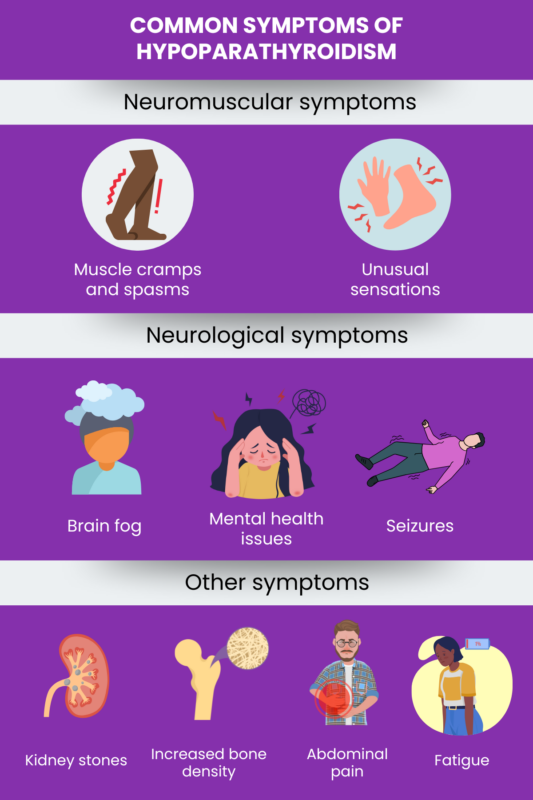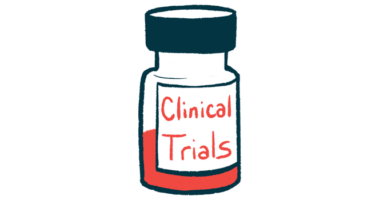Hypoparathyroidism symptoms
Last updated May 30, 2025, by Marisa Wexler, MS

Hypoparathyroidism is a rare disorder marked by abnormally low levels of parathyroid hormone (PTH), a signaling molecule that helps regulate calcium levels and supports the health of several organs and tissues.
Hypoparathyroidism symptoms can range from muscle spasms and bone problems to kidney issues, seizures, and heart problems. These symptoms can vary widely from person to person, and also change over time in the same person.
All hypoparathyroidism types — including acquired hypoparathyroidism, autoimmune hypoparathyroidism, congenital hypoparathyroidism, and familial isolated hypoparathyroidism, as well as idiopathic hypoparathyroidism, where the condition has no known cause — are marked by low PTH levels. As a result, they generally share the same core symptoms, although tests to establish a definitive hypoparathyroidism diagnosis and treatment may differ based on the underlying hypoparathyroidism causes.
Common symptoms of hypoparathyroidism
Hypoparathyroidism signs and symptoms can affect many different organs and tissues, most often the muscles and the nervous system. Other organs, including the kidneys, bones, and heart, also may be affected.
Common neuromuscular symptoms of hypoparathyroidism include:
- muscle spasms, especially in the face and extremities
- muscle cramps, aches, and/or twitches
- unusual sensations such as burning, prickling, or a feeling of pins and needles in the extremities and around the mouth.
Among common neurological symptoms are:
- brain fog or confusion
- mental health issues such as depression or anxiety
- seizures.
Other common hypoparathyroidism signs and symptoms include:
- kidney stones and reduced kidney function
- increased bone density
- abdominal pain
- fatigue or weakness.

Early signs to look out for
Symptoms of hypoparathyroidism often start gradually and can be mild at first. Many people experience mild symptoms for years before being diagnosed.
Recognizing hypoparathyroidism early signs can help ensure that patients receive timely care. It’s important to seek medical advice if a person experiences any of the following:
- tingling or numbness in the hands, feet, or around the mouth
- brain fog or mental health issues
- muscle cramps, spasms, and trembling or twitching
- unexplained fatigue
- irritability and mood swings
- sensitivity to sound.
Less common symptoms of hypoparathyroidism
While symptoms affecting the muscles or nervous system are more commonly observed, some people develop rarer symptoms of hypoparathyroidism, affecting other parts of the body.
These less common symptoms are more likely to develop in cases in which the condition remains untreated or does not respond adequately to treatment. More rare symptoms of hypoparathyroidism may include:
- abnormal heart rhythms and heart failure
- dental issues such as weakened tooth enamel and an increased risk of cavities
- skin symptoms such as dry or scaly skin, brittle nails, and coarse or thin hair
- cataracts, marked by a clouding of the lens in the eye, which leads to impaired vision.
Hypoparathyroidism symptoms by age
Hypoparathyroidism can occur at any age, ranging from children to the elderly, and symptoms are broadly similar across age groups.
Untreated hypoparathyroidism in children can cause problems with bone development, resulting in impaired growth, as well as slower mental development. Children also may experience dental problems, such as late-developing teeth or root malformation.
In adults, chronic hypoparathyroidism has been associated with poorer attention and processing speed — which refers to how quickly the brain takes in, interprets, and responds to information — as well as worse memory and executive function. Executive function involves cognitive skills that help people make plans, solve problems, and adapt to new situations.
Does hypoparathyroidism cause hypocalcemia?
Hypocalcemia, or low levels of calcium in the blood, is one of the hallmark features of hypoparathyroidism. In fact, most symptoms of hypoparathyroidism are actually calcium deficiency symptoms.
PTH, the hormone that is found at low levels in people with the disease, normally regulates calcium levels by:
- releasing calcium from the bones, where calcium is primarily stored
- stimulating the kidneys to produce active vitamin D, which boosts calcium absorption in the intestines
- reducing the amount of calcium that is excreted in the urine.
When PTH is deficient, these processes become abnormal, leading to low calcium levels and a range of disease symptoms. Thus, normalizing calcium levels is a cornerstone treatment approach for the disorder. This is usually done with daily supplements with calcium and active vitamin D.
In acute cases of hypocalcemia, where symptoms may become life-threatening, calcium may be given intravenously, or into the bloodstream. Continuous heart monitoring is often required in these situations.
Importantly, calcium levels aren’t always enough to predict symptom severity in people with hypoparathyroidism — for the same level of calcium, some patients may experience significant symptoms and others will be asymptomatic.
Hypoparathyroidism News is strictly a news and information website about the disease. It does not provide medical advice, diagnosis, or treatment. This content is not intended to be a substitute for professional medical advice, diagnosis, or treatment. Always seek the advice of your physician or other qualified health provider with any questions you may have regarding a medical condition. Never disregard professional medical advice or delay in seeking it because of something you have read on this website.
Recent Posts
- Lesson learned: I listened to my body before a dizzy spell became a crisis
- Going from patient to caregiver is helping me accept my own needs
- The lifesaving advice my 40-year-old self would give my teenage self
- Yorvipath found to sustain kidney function gains over 3 years
- Finding my purpose 10,000 days after my hypopara diagnosis
Related articles
-
November 14, 2025 by Heather Novak
Lesson learned: I listened to my body before a dizzy spell became a crisis
-
November 12, 2025 by Bari Vapnek
Going from patient to caregiver is helping me accept my own needs
-
November 7, 2025 by Heather Novak
The lifesaving advice my 40-year-old self would give my teenage self
-
November 5, 2025 by Bari Vapnek
Finding my purpose 10,000 days after my hypopara diagnosis
-
October 31, 2025 by Heather Novak
Getting to the bottom of a surprise medical bill took years



